Antibody data
- Antibody Data
- Antigen structure
- References [0]
- Comments [0]
- Validations
- Western blot [1]
- ELISA [5]
- Immunohistochemistry [2]
Submit
Validation data
Reference
Comment
Report error
- Product number
- LS-C355408 - Provider product page

- Provider
- LSBio
- Product name
- APOA1 / Apolipoprotein A 1 Antibody (clone 6001) LS-C355408
- Antibody type
- Monoclonal
- Description
- Ion exchange chromatography
- Reactivity
- Human
- Host
- Mouse
- Isotype
- IgG
- Antibody clone number
- 6001
- Storage
- Short term: store at 4°C. Long term: aliquot and store at -20°C. Avoid freeze-thaw cycles.
No comments: Submit comment
Enhanced validation
- Submitted by
- LSBio (provider)
- Enhanced method
- Genetic validation
- Main image
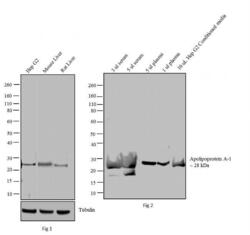
- Experimental details
- Apolipoprotein A-1 Western Blot
Supportive validation
- Submitted by
- LSBio (provider)
- Enhanced method
- Genetic validation
- Main image
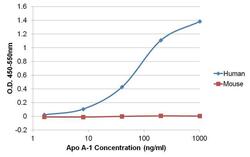
- Experimental details
- Sandwich ELISA of Apolipoprotein A-1 was performed by coating wells of a 96-well plate with 100ul of an Apo A-1 rabbit oligoclonal antibody diluted to a concentration of 1 µg/mL in carbonate/bicarbonate buffer overnight at 4C. Wells were blocked with 150ul of StartingBlock T20 (TBS) Blocking Buffer for 30 minutes, and 80ul of recombinant human Apo A-1 or recombinant mouse Apo A-1 was added to the plate at concentrations ranging from 1.6-1000ng/ml and incubated for 1 hour at room temperature. The plate was washed with 1X TBST, and 100ul per well of an Apo A-1 mouse monoclonal antibody was added to each well for 1 hour at room temperature. The plate was washed, and 100ul per well of an HRP-conjugated rabbit anti-mouse IgG cross-adsorbed secondary antibody was incubated for 30 minutes at room temperature. Detection was performed using 1-Step Ultra TMB Substrate, followed by Stop Solution. Absorbances were read on a spectrophotometer at 450-550nm.
- Submitted by
- LSBio (provider)
- Enhanced method
- Genetic validation
- Main image
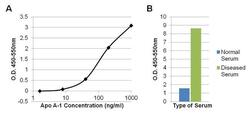
- Experimental details
- Sandwich ELISA of Apolipoprotein A-1 was performed by coating wells of a 96-well plate with 100ul of an Apo A-1 rabbit oligoclonal antibody at a concentration of 1 µg/mL in carbonate/bicarbonate buffer overnight at 4C. Wells were blocked with 150ul of StartingBlock T20 (TBS) Blocking Buffer for 30 minutes, and 80ul of recombinant human Apo A-1 standards ranging from 1.6-1000ng/ml (A) or 100ul of diluted normal human serum or diluted serum from a patient with dyslipidemia (B) were incubated for 1 hour at room temperature. The plate was washed with 1X TBST, and 100ul per well of an Apo A-1 mouse monoclonal antibody was added to each well for 1 hour at room temperature. The plate was washed, and 100ul per well of a biotinylated rabbit anti-mouse IgG Superclonal secondary antibody was incubated for 1 hour, followed by Streptavidin-HRP for 30 minutes. Detection was performed using 1-Step Ultra TMB Substrate, followed by Stop Solution. Absorbances were read on a spectrophotometer at 450-550nm.
- Submitted by
- LSBio (provider)
- Main image
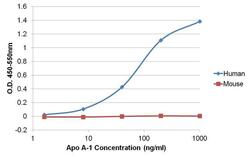
- Experimental details
- Sandwich ELISA of Apolipoprotein A-1 was performed by coating wells of a 96-well plate with 100ul of an Apo A-1 rabbit oligoclonal antibody diluted to a concentration of 1 µg/mL in carbonate/bicarbonate buffer overnight at 4C. Wells were blocked with 150ul of StartingBlock T20 (TBS) Blocking Buffer for 30 minutes, and 80ul of recombinant human Apo A-1 or recombinant mouse Apo A-1 was added to the plate at concentrations ranging from 1.6-1000ng/ml and incubated for 1 hour at room temperature. The plate was washed with 1X TBST, and 100ul per well of an Apo A-1 mouse monoclonal antibody was added to each well for 1 hour at room temperature. The plate was washed, and 100ul per well of an HRP-conjugated rabbit anti-mouse IgG cross-adsorbed secondary antibody was incubated for 30 minutes at room temperature. Detection was performed using 1-Step Ultra TMB Substrate, followed by Stop Solution. Absorbances were read on a spectrophotometer at 450-550nm.
- Submitted by
- LSBio (provider)
- Main image

- Experimental details
- Sandwich ELISA of Apolipoprotein A-1 was performed by coating wells of a 96-well plate with 100ul of an Apo A-1 rabbit oligoclonal antibody at a concentration of 1 µg/mL in carbonate/bicarbonate buffer overnight at 4C. Wells were blocked with 150ul of StartingBlock T20 (TBS) Blocking Buffer for 30 minutes, and 80ul of recombinant human Apo A-1 standards ranging from 1.6-1000ng/ml (A) or 100ul of diluted normal human serum or diluted serum from a patient with dyslipidemia (B) were incubated for 1 hour at room temperature. The plate was washed with 1X TBST, and 100ul per well of an Apo A-1 mouse monoclonal antibody was added to each well for 1 hour at room temperature. The plate was washed, and 100ul per well of a biotinylated rabbit anti-mouse IgG Superclonal secondary antibody was incubated for 1 hour, followed by Streptavidin-HRP for 30 minutes. Detection was performed using 1-Step Ultra TMB Substrate, followed by Stop Solution. Absorbances were read on a spectrophotometer at 450-550nm.
- Submitted by
- LSBio (provider)
- Main image
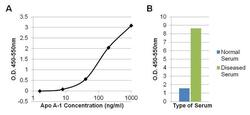
- Experimental details
- Sandwich ELISA of Apolipoprotein A-1 was performed by coating wells of a 96-well plate with 100ul of an Apo A-1 rabbit oligoclonal antibody at a concentration of 1 µg/mL in carbonate/bicarbonate buffer overnight at 4C. Wells were blocked with 150ul of StartingBlock T20 (TBS) Blocking Buffer for 30 minutes, and 80ul of recombinant human Apo A-1 standards ranging from 1.6-1000ng/ml (A) or 100ul of diluted normal human serum or diluted serum from a patient with dyslipidemia (B) were incubated for 1 hour at room temperature. The plate was washed with 1X TBST, and 100ul per well of an Apo A-1 mouse monoclonal antibody was added to each well for 1 hour at room temperature. The plate was washed, and 100ul per well of a biotinylated rabbit anti-mouse IgG Superclonal secondary antibody was incubated for 1 hour, followed by Streptavidin-HRP for 30 minutes. Detection was performed using 1-Step Ultra TMB Substrate, followed by Stop Solution. Absorbances were read on a spectrophotometer at 450-550nm.
Supportive validation
- Submitted by
- LSBio (provider)
- Enhanced method
- Genetic validation
- Main image
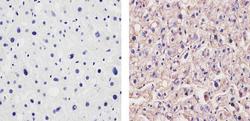
- Experimental details
- Immunohistochemistry analysis of Apolipoprotein A-1 showing staining in the cytoplasm of paraffin-embedded human liver tissue (right) compared to a negative control without primary antibody (left). To expose target proteins, antigen retrieval was performed using 10mM sodium citrate (pH 6.0), microwaved for 8-15 min. Following antigen retrieval, tissues were blocked in 3% H2O2-methanol for 15 min at room temperature, washed with ddH2O and PBS, and then probed with a Apolipoprotein A-1 Mouse Monoclonal Antibody. Proteins were transferred to a Nitrocellulose Membrane using the G2 Fast Blotter, and blocked with 5% milk in TBST for at least 1 hour at room temperature. Apo A-1 was detected at ~50kD using an Apolipoprotein A-1 monoclonal antibody at a dilution of 1:1000 in blocking buffer overnight at 4C on a rocking platform, followed by an HRP-conjugated goat anti-mouse IgG Fc-specific secondary antibody at a dilution of 1:40,000 for at least 30 minutes at room temperature. Chemiluminescent detection was performed using SuperSignal West Dura.
- Submitted by
- LSBio (provider)
- Enhanced method
- Genetic validation
- Main image
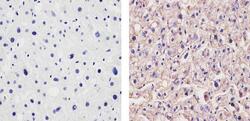
- Experimental details
- Immunohistochemistry analysis of Apolipoprotein A-1 showing staining in the cytoplasm of paraffin-embedded human liver tissue (right) compared to a negative control without primary antibody (left). To expose target proteins, antigen retrieval was performed using 10mM sodium citrate (pH 6.0), microwaved for 8-15 min. Following antigen retrieval, tissues were blocked in 3% H2O2-methanol for 15 min at room temperature, washed with ddH2O and PBS, and then probed with a Apolipoprotein A-1 Mouse Monoclonal Antibody. Proteins were transferred to a Nitrocellulose Membrane using the G2 Fast Blotter, and blocked with 5% milk in TBST for at least 1 hour at room temperature. Apo A-1 was detected at ~50kD using an Apolipoprotein A-1 monoclonal antibody at a dilution of 1:1000 in blocking buffer overnight at 4C on a rocking platform, followed by an HRP-conjugated goat anti-mouse IgG Fc-specific secondary antibody at a dilution of 1:40,000 for at least 30 minutes at room temperature. Chemiluminescent detection was performed using SuperSignal West Dura.
 Explore
Explore Validate
Validate Learn
Learn Western blot
Western blot ELISA
ELISA Radioimmunoassay
Radioimmunoassay